Roots over routes - why F1 needs Spa to remain on it's calendar
An ode to Spa-Francorchamps
Thank you for being here. You are receiving this email because you subscribed to Idée Fixe, the newsletter for curious minds. I’m Toni Cowan-Brown, a tech and F1 commentator. I’m a former tech executive who has spent the past five years on the floor of way too many F1, FE, and WEC team garages, learning about the business, politics, and technology of motorsports.
⏳ Reading time: 7min
Spa 1991 was my first Formula 1 race - it also happened to be Michael Schumacher’s first F1 weekend, he debuted with Jordan, qualified P7, and retired on lap 1 with a clutch failure. I was a kid living in Brussels at the time, and the Belgian Grand Prix sort of became my home race - claimed, not assigned. My dad would take me back; later, as a student, I returned to the hustle, selling merchandise at Spa (and at the French GP) just to be near the noise and the fans. Then life sped up. I didn’t make it back for more than a decade.
This year I finally returned, and to work with the promoters to tell Spa’s story. Walking the same inclines I climbed as a teenager, hearing the engines ricochet through the trees, felt like opening a time capsule and finding it still alive. This place isn’t just a circuit to me; it’s a reminder of family weekends, first jobs, and the moment I fell for this sport. The Spa GP weekend also got me thinking about the F1 calendar.
So today’s piece is part love letter, part argument: why Spa matters, why it shouldn’t be shuffled into rotation, and how a modern F1 calendar can grow without losing its roots.
The Ardennes Clause: the non-negotiable race on a negotiable calendar
If Formula 1 has a north star - a place that points the sport back to what it’s supposed to feel like - it’s Spa-Francorchamps. A seven-kilometre ribbon that dives and climbs through the Ardennes, Spa asks drivers for bravery on every lap and pays them back with flow. The numbers alone hint at why it’s mythic: 7.004 km in length and a colossal ~102 metres of elevation change -the biggest on the calendar - compacting physics into the breath-held sprint through Eau Rouge/Raidillon and the exhale onto the Kemmel Straight.
Spa’s roots run deep. The Belgian Grand Prix first visited in 1925 on an ultra-fast, 14-kilometre road course that stitched together public routes and rural life - farmhouses, hedgerows, and the kind of danger that defined early Grand Prix racing. As safety standards rose, Spa did what great venues do: it evolved without losing its soul. A modernised layout emerged in the late 1970s/early 1980s, preserving the character while taming the worst excesses. Since then, Spa has remained a touchstone: demanding, fast, legible to fans even at TV speed.
And it keeps investing to stay worthy of the calendar. In 2022 the circuit completed a €25m safety and infrastructure programme (bigger run-offs, reprofiled gravel, improved spectator areas), part heritage care, part practical step to future-proof the venue. More recently, two new grandstands pushed capacity up by ~10,000 and upgraded the off-track experience - recognition that the “old soul” can still deliver a modern weekend. It’s not just romance and track maps. Fans vote with their feet. Spa drew around 380,000 people across the weekend in both 2023 and 2024 - record-matching numbers, and proof that a “classic” can still be a blockbuster.
Why drivers (still) call it a favourite
Talk to drivers and you hear the same refrain: commitment. From the compression at Eau Rouge to the knife-edge through Pouhon, Spa rewards courage and car control more than DRS gimmickry. Add the Ardennes micro-climate - sun at La Source, rain at Les Combes - and you get variable conditions that test racecraft and engineering judgement in real time. That unpredictability isn’t chaos; it’s character. Or as Sir Lewis Hamilton described it - “It’s the only track where you feel like you are going somewhere”.
The awkward truth about the F1 calendar
F1 has a hard cap of 24 races in 2025. The official language around calendar design is now “regionalisation” - fewer criss-cross flights, clusters that make carbon and cost sense (e.g., Japan moved to April to sit with other Asia-Pacific rounds, Ramadan timing considered for Gulf events). It’s rational, overdue, and constraining. Every new destination forces a trade.
Financial gravity pulls, too. Race-promotion revenue has become a key growth lever for Liberty Media - fees have escalated, hospitality keeps expanding but also getting better, and the calendar is one of the sport’s most powerful P&L tools. Hosts that can pay premium fees, guarantee city-scale spectacle, and fit the regional puzzle get leverage. That doesn’t make the calendar “pay-to-play,” but it does mean race-by-race politics are real.
Europe, meanwhile, is crowded (and rightfully so), but promoters are being faced with increasing price demands - some tracks only possible because of government subsidies... Madrid joins from 2026 on a 10-year deal, adding pressure to a continent that already houses many legacy events. The result is the concept F1 has been openly socialising for a while: rotation, especially among European rounds.
So the big question is “why is the calendar the way it is?” Well, the short version is because it’s a three-way optimisation problem with no perfect solution:
Money & media: Cities (and countries) pay to host; F1 sells global reach and hospitality. Race fees and Paddock Club revenues are rising, which nudges the calendar toward markets willing to underwrite spectacle.
Logistics & sustainability: F1 is (slowly) clustering by region to reduce freight miles and align with its net-zero 2030 messaging. That’s why you see Japan in April, and Gulf races adjusted around Ramadan in 2025. Promoters also want to ensure that the races fall at the most optimised time during their tourism calendar.
Politics & legacy: Historic venues want certainty; new markets want in. With Madrid locked 2026–35 and continued interest from Africa and Asia, something has to give. Rotation is the political release valve.
Spa’s new reality and why I still say “no” to rotation
In January, F1 announced a multi-year extension for the Belgian GP that quietly bakes in rotation: Spa returns in 2026, 2027, 2029 and 2031, and sits out 2028 and 2030. It’s a diplomatic way to keep a classic while making room elsewhere, but it also formalises the idea that even the temples aren’t sacred. I think that’s a mistake, specifically for Spa.
1) Heritage anchors matter.
F1 needs a spine of “fixed points” that articulate its identity across eras: circuits where context lives in the kerbs. For me that core is Monaco, Silverstone, Monza, Suzuka and Spa. These are not just venues; they’re the sport’s reference laps. Removing Spa in alternate years weakens the through-line that lets fans measure drivers and machines against history. The whole selling point of a 75-year World Championship is continuity. Rotating your continuity is a strange strategy. (Note: even F1’s own communications lean on Spa’s historic status when justifying renewal.)
2) Sporting diversity > city-event monoculture.
The modern calendar is tilting toward street-adjacent spectacles. Those are commercially powerful and visually dazzling (think Singapore and Vegas). But the championship also needs high-commitment road courses where aero efficiency, tyre energy management, and driver bravery interact in ways a 90-degree street layout can’t replicate. Spa is a unique technical filter, why deliberately delete that sample every other year?
3) The fan pilgrimage is real and working.
Attendance has been elite, and upgrades have made the experience better in practical ways (ingress/egress, viewing, entertainment). For a European summer audience that blends die-hards with Drive to Survive-era newcomers, Spa is both a destination and an education in all things Formula 1. If the calendar must rotate, logic says you rotate where demand is fragile or the experience is generic - not where fans are already showing up in huge numbers.
4) Weather as feature, not bug.
Yes, the Ardennes can be chaotic. But variability is part of sport’s appeal and Spa’s micro-climate enhances, rather than detracts, from the challenge. Sprint or no sprint, wet or dry, Spa produces meaningful data points about driver and team adaptability. That’s content fans actually value.
What the next few years could look like (good and bad)
Good scenario: F1 defines a formal “Heritage Spine” of five fixed rounds (Monaco, Silverstone, Monza, Suzuka, Spa) that do not rotate. Around that, it regionalises tightly - Americas, Europe, Middle East, Asia-Pacific - so teams and fans can plan and the sport lowers freight miles credibly. New destinations find their place without evicting identity circuits; rotation applies to second-tier overlaps (e.g., between multiple races in the same market). Spa becomes an annual anchor again.
Bad scenario: Rotation expands from exception to norm in Europe - a little like teh double and triple headers have now become a norm, which is possibly the only thing I dislike about the sport. Italy likely drops to one race long-term; Spain’s internal tug-of-war intensifies post-2026 with Madrid’s arrival; and classic venues become biennial postcards - great for scarcity marketing, not great for narrative continuity. We get more “event” weekends and fewer “racing” ones.
To be clear, I’m not arguing against growth or new markets. I’m arguing for coherence. F1 is a global entertainment product and a sporting lineage. The calendar should reflect both. Keep expanding - bring South Africa back, bed in new fans in cities that want to host - but protect the handful of places that test the essence of a Grand Prix car and a Grand Prix driver.
Spa does that, uniquely. It’s a driver’s delight, a fan magnet, a technical outlier, and a living museum that isn’t stuck in amber. The venue has invested, the crowds have responded, and the racing - the real, weather-spiced, bravery-dependent kind - keeps delivering. The sport can afford many rotations. This shouldn’t be one of them.
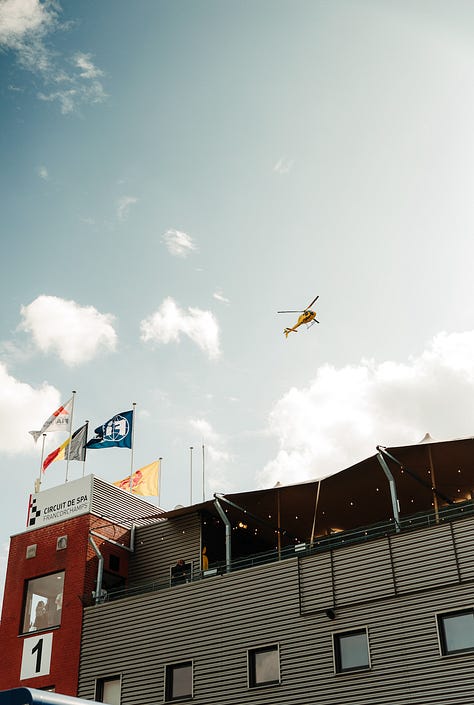

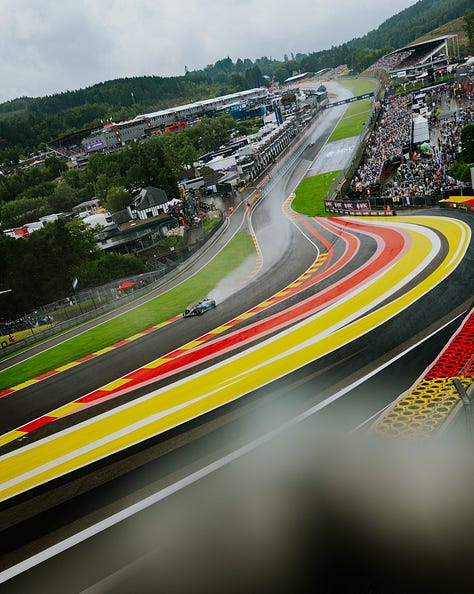

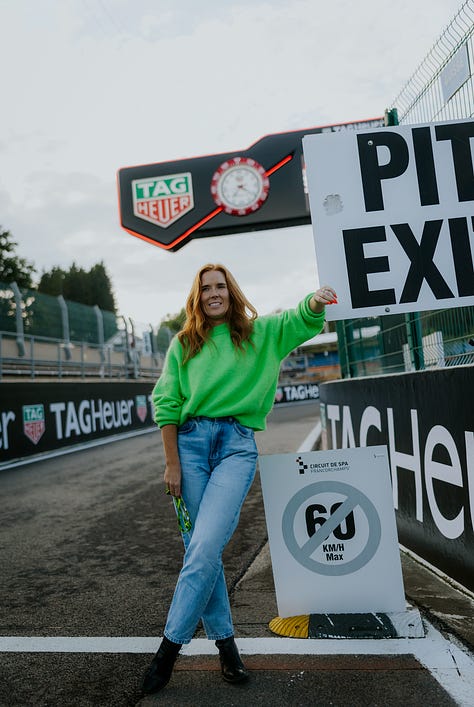

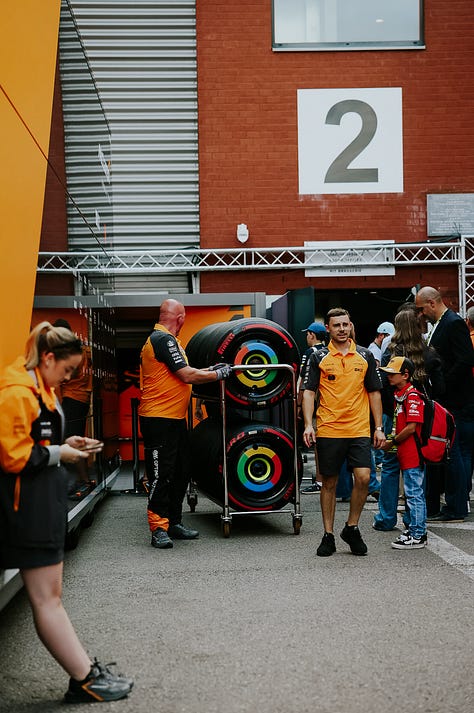


🔗 Adidas Is Serious About Investing in Formula 1 | SportsVerse
Another banger of a piece by the one and only DYM. When Adidas first announced its landmark partnership with the Mercedes AMG F1 team at the start of this year, people were sceptical. There were questions as to why a brand would make such a significant investment in a partnership with Mercedes F1, given that the team had just lost Lewis Hamilton, the sport’s one true breakout cultural sensation and undoubtedly its greatest (and only) fashion icon. Read here.
🔗 Sports Is Having Its “Religion Moment” | Profluence Sports
Many of you aren’t grasping what’s really at stake in sports. We’re not just at the start of another “innovation cycle”… We’re staring at the beginning of the end of league dominance (and the rise of a new era, one where athletes build the leagues themselves). Read here.



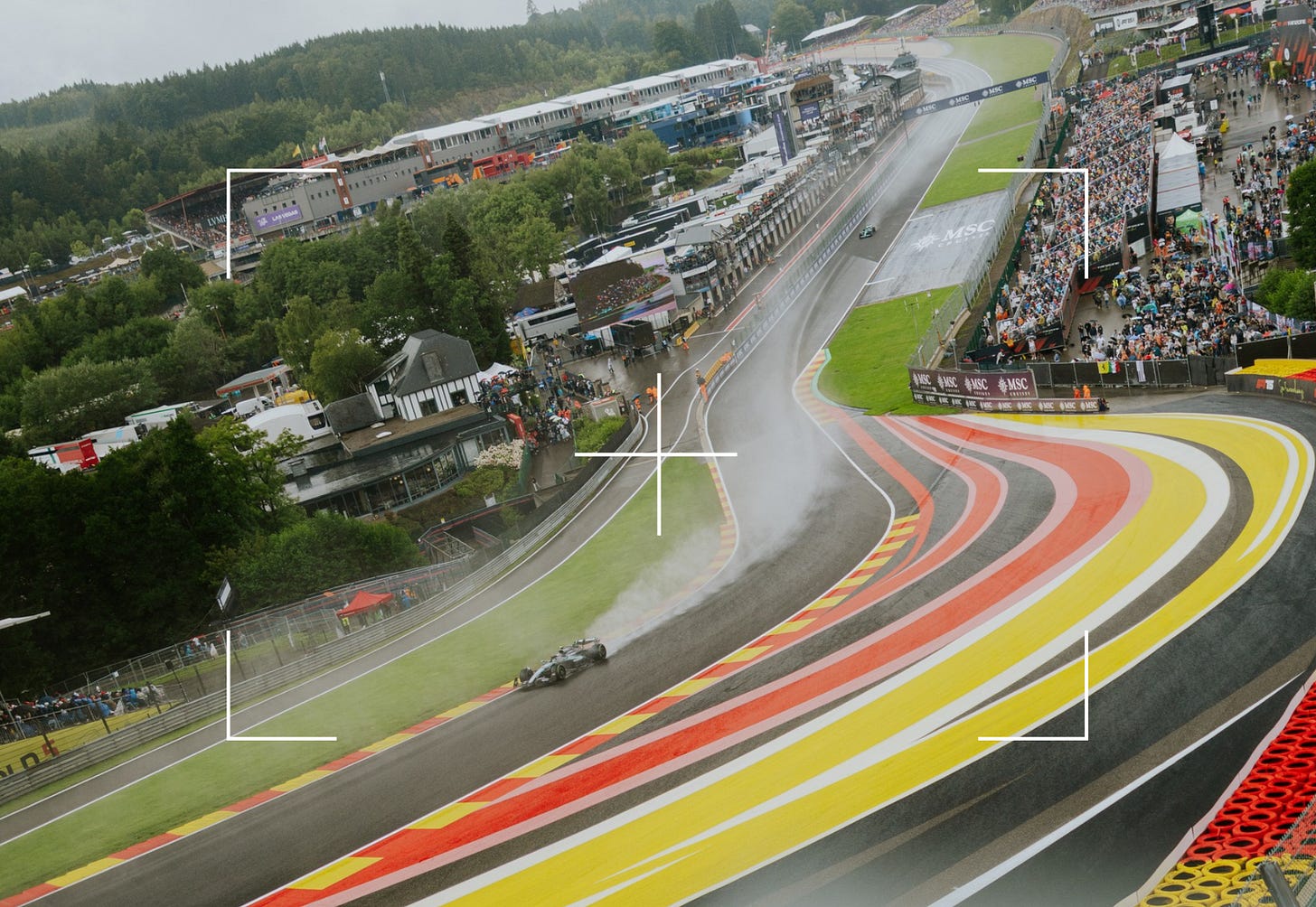
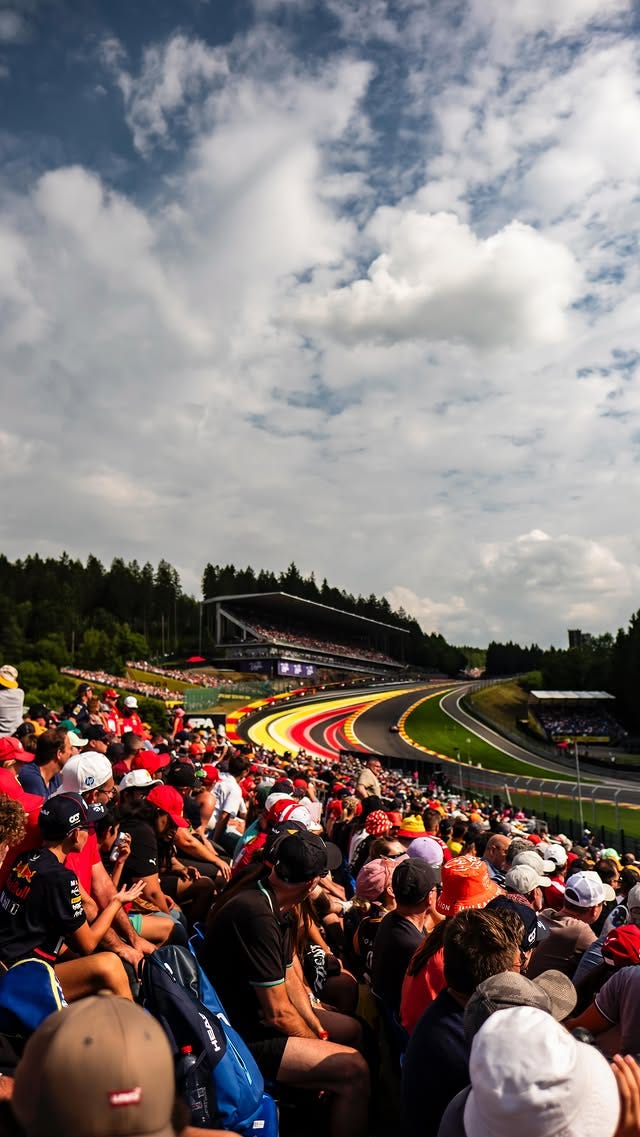


Fully support the Heritage Spine concept. I’m a newer F1 fan, but I’ve gone headfirst into the history…watching old race clips and documentaries of large legends of yesterday. I don’t want to lose the very racing that made F1 what it is. It’s like the Girl Scout song…make new friends, but keep the old 😊
The ‘heritage spine’ is a great concept ! I’m a younger fan so I’m all for seeing new tracks but I’ve been following F1 for most of my life and don’t want to see the iconic tracks I grew up with disappear. I am worried that F1 is becoming more of a show than a sport though. I understand that’s it’s arguably an entertainment industry but it seems to me like the entertainment being provided is more a celebrity event than quality racing.